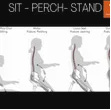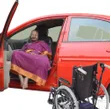Spasms in Paraplegics during transfers
posted on - 2023-02-22
Spasms are an involuntary and sudden contraction of muscles that can cause pain, discomfort, and even loss of balance or control of movement. Paraplegics and spinal injury patients often experience spasms, particularly during wheelchair to vehicle transfers, and when they are picked up and lowered down manually with the help of a caregiver or assistant. In this blog, we will explore the medical reasons behind spasms in these instances and how they can be managed.
Spasms are a common occurrence in paraplegics and spinal injury patients due to the injury or damage to the spinal cord. The spinal cord is responsible for transmitting messages between the brain and the rest of the body, including the muscles. When the spinal cord is damaged, the messages can become mixed up, resulting in spasms and other movement disorders. In particular, damage to the lower part of the spinal cord can cause spasticity, which is a condition characterized by increased muscle tone and reflexes, leading to spasms and stiffness.
When transferring from a wheelchair to a vehicle, paraplegics and spinal injury patients often have to adjust their body position and use their upper body strength to lift themselves up and over the threshold of the vehicle. This movement can trigger muscle spasms, particularly in the lower back and legs, due to the sudden change in position and weight distribution. Similarly, when patients are lifted manually, the sudden change in posture and weight distribution can also cause spasms. These spasms can make the transfer process difficult and uncomfortable, making it important to manage them effectively.
One way to manage spasms is to use medication. Antispasmodic drugs such as baclofen or diazepam can be prescribed by a doctor to help relax the muscles and reduce spasticity. These medications work by binding to receptors in the brain and spinal cord that control muscle tone, leading to a decrease in muscle spasticity and spasms.
Another way to manage spasms is through physical therapy. A physical therapist can work with patients to develop exercises and stretching routines that help to reduce muscle spasticity and increase flexibility. These exercises can also help to improve overall strength and balance, making the transfer process easier and more comfortable.
In some cases, the use of assistive devices such as transfer boards or patient lifts can also help to reduce spasms. These devices can help to support the patient’s weight and provide a more stable and controlled transfer, reducing the risk of sudden movements and spasms.
In conclusion, spasms are a common occurrence in paraplegics and spinal injury patients, particularly during wheelchair to vehicle transfers and manual lifting. These spasms are caused by damage to the spinal cord, which can result in spasticity and increased muscle tone. However, with the help of medication, physical therapy, and assistive devices, these spasms can be effectively managed, making the transfer process easier and more comfortable for the patient. If you or a loved one is experiencing spasms, it is important to speak with a doctor or physical therapist to determine the best course of treatment.
Here are some tips to help:
- Stretch before the transfer: Before attempting a transfer, it’s important for the patient to stretch their muscles to prevent spasms. Stretching can help to increase flexibility and reduce muscle tension.
- Use proper lifting techniques: It’s important to use proper lifting techniques when transferring a paraplegic person into a vehicle. This can help to prevent injury and reduce the risk of muscle spasms. Make sure to use the legs and not the back to lift the person, and to keep the person as close to your body as possible.
- Use a transfer board: A transfer board is a flat, sturdy board that can be used to transfer a person from one surface to another. Using a transfer board can help to reduce the strain on the patient’s muscles and make the transfer process smoother and more comfortable.
- Move slowly and carefully: When transferring a paraplegic person into a vehicle, it’s important to move slowly and carefully to avoid sudden movements that can trigger muscle spasms. Take your time and communicate with the patient to ensure that they are comfortable throughout the transfer process.
- Maintain a comfortable temperature: Keeping the patient warm and comfortable can help to prevent muscle spasms. Make sure that the vehicle is at a comfortable temperature, and use blankets or heating pads if necessary.
- Consider using assistive devices: There are a variety of assistive devices that can be used to help with transferring a paraplegic person into a vehicle, such as a complete mobility solution (wheelchair car transfer swivel seat). These devices can help to reduce the strain on the patient’s muscles and make the transfer process smoother and more comfortable.
Overall, it’s important to take the time to plan and prepare for a paraplegic patient transfer and to prioritize the patient’s comfort and safety throughout the process.







